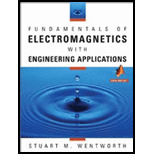
Fundamentals of Electromagnetics with Engineering Applications
1st Edition
ISBN: 9780470105757
Author: Stuart M. Wentworth
Publisher: Wiley, John & Sons, Incorporated
expand_more
expand_more
format_list_bulleted
Question
Chapter 5, Problem 5.49P
(a)
To determine
The angle of transmission for TM polarized wave.
(b)
To determine
The coefficients for reflection and transmission.
(c)
To determine
The electric and magnetic field for incident, transmitted and reflected wave.
Expert Solution & Answer
Want to see the full answer?
Check out a sample textbook solution
Students have asked these similar questions
13. Find i(t) for t > 0 in the following circuit
Calculate the Capacitor Voltage for t > 0 assuming the switch has been open for long time.
14. Find i(t) for t > 0 in the following circuit Note: the current source is only ON for t > 0. So, it would be an open circuit for t < 0
Chapter 5 Solutions
Fundamentals of Electromagnetics with Engineering Applications
Ch. 5 - Starting with Maxwells equations for simple,...Ch. 5 - Derive (5.10) by starting with the phasor point...Ch. 5 - A wave with =6.0cm in air is incident on a...Ch. 5 - Suppose Hs(z)=Hys(z)ay. Start with (5.14) and...Ch. 5 - Given =1.0105S/m,r=2.0,r=50., and f=10.MHz, find...Ch. 5 - In some material, the constitutive parameters are...Ch. 5 - Prob. 5.7PCh. 5 - Prob. 5.8PCh. 5 - Prob. 5.9PCh. 5 - A 100-MHz wave in free space propagates in the y...
Ch. 5 - In a lossless, nonmagnetic material with...Ch. 5 - Given E=120cos(6106t0.080y)azV/m and...Ch. 5 - Work through the algebra to derive the and...Ch. 5 - Prob. 5.15PCh. 5 - In a medium with properties =0.00964S/m,r=1.0, and...Ch. 5 - Make a pair of plots similar to Figure 5.4 for the...Ch. 5 - Starting with (5.13), show that = for a good...Ch. 5 - Prob. 5.19PCh. 5 - Calculate the skin depth at 1.00 GHz for (a)...Ch. 5 - Prob. 5.21PCh. 5 - Prob. 5.22PCh. 5 - In a nonmagnetic material,...Ch. 5 - Prob. 5.24PCh. 5 - Prob. 5.25PCh. 5 - In air, H(z,t)=12.cos(106tz+/6)axA/m. Determine...Ch. 5 - A 600-MHz uniform plane wave incident in the z...Ch. 5 - Prob. 5.28PCh. 5 - Prob. 5.29PCh. 5 - Prob. 5.30PCh. 5 - Prob. 5.31PCh. 5 - Prob. 5.32PCh. 5 - Prob. 5.33PCh. 5 - Prob. 5.34PCh. 5 - For a general elliptical polarization represented...Ch. 5 - Prob. 5.36PCh. 5 - Prob. 5.37PCh. 5 - Suppose medium 1(z0) is air and medium 2(z0) has...Ch. 5 - Suppose a UPW in air carrying an average power...Ch. 5 - Prob. 5.40PCh. 5 - Prob. 5.41PCh. 5 - Prob. 5.42PCh. 5 - Prob. 5.43PCh. 5 - Prob. 5.44PCh. 5 - Prob. 5.45PCh. 5 - A wave specified by Ei=100.cos(107t1z)axV/m is...Ch. 5 - A wave specified by Ei=12cos(2107t1z+/4)axV/m is...Ch. 5 - Prob. 5.48PCh. 5 - Prob. 5.49PCh. 5 - A randomly polarized UPW at 200 MHz is incident at...
Knowledge Booster
Similar questions
- 10. Find v(t) for t > 0 in the following circuit. Note: the current source is only ON for t > 0. So, it would be an open circuit for t < 0arrow_forward3. Calculate the Capacitor Voltage for the t 0 for the following circuit. 302 292 12 V 4 V 3 F 2arrow_forward12. Find v(t) and i(t) for t > 0 in the following circuit • Note: the current source is only ON for t > 0. So, it would be an open circuit for t < 0 • Note: assume v(0) = 0V and i(0) = 0A.arrow_forward
- 6. Determine the inductor current i(t) for the t 0 for the following circuit 1=0 6 A ww 40 20 ele 3 Harrow_forward11. Find v(t) and i(t) for t > 0 in the following circuit. Note: the current source is only ON for t > 0. So, it would be an open circuit for t < 0arrow_forward8. Determine the inductor current i(t) for the t < 0 and t > 0 for the following circuitarrow_forward
- 1. Calculate the Capacitor Voltage for the t < 0 and t > 0 for the following circuit.arrow_forwardDon't use ai to answer I will report you answer..arrow_forwardQ) For the RC circuit shown in Fig. 1, S is closed at t=0 sec. S is opened at t = 150 usec, a) Write the mathematical expression for ic and vc for t=0 sec. to 1=150 usec. b) Write the mathematical expression for ic and vc for t≥150 μsec. c) Sketch ic and ve on the same time axis. Fig.1 12A S 10 Ohm 5 Ohm 2 uF 15 Ohmarrow_forward
arrow_back_ios
SEE MORE QUESTIONS
arrow_forward_ios
Recommended textbooks for you
 Introductory Circuit Analysis (13th Edition)Electrical EngineeringISBN:9780133923605Author:Robert L. BoylestadPublisher:PEARSON
Introductory Circuit Analysis (13th Edition)Electrical EngineeringISBN:9780133923605Author:Robert L. BoylestadPublisher:PEARSON Delmar's Standard Textbook Of ElectricityElectrical EngineeringISBN:9781337900348Author:Stephen L. HermanPublisher:Cengage Learning
Delmar's Standard Textbook Of ElectricityElectrical EngineeringISBN:9781337900348Author:Stephen L. HermanPublisher:Cengage Learning Programmable Logic ControllersElectrical EngineeringISBN:9780073373843Author:Frank D. PetruzellaPublisher:McGraw-Hill Education
Programmable Logic ControllersElectrical EngineeringISBN:9780073373843Author:Frank D. PetruzellaPublisher:McGraw-Hill Education Fundamentals of Electric CircuitsElectrical EngineeringISBN:9780078028229Author:Charles K Alexander, Matthew SadikuPublisher:McGraw-Hill Education
Fundamentals of Electric CircuitsElectrical EngineeringISBN:9780078028229Author:Charles K Alexander, Matthew SadikuPublisher:McGraw-Hill Education Electric Circuits. (11th Edition)Electrical EngineeringISBN:9780134746968Author:James W. Nilsson, Susan RiedelPublisher:PEARSON
Electric Circuits. (11th Edition)Electrical EngineeringISBN:9780134746968Author:James W. Nilsson, Susan RiedelPublisher:PEARSON Engineering ElectromagneticsElectrical EngineeringISBN:9780078028151Author:Hayt, William H. (william Hart), Jr, BUCK, John A.Publisher:Mcgraw-hill Education,
Engineering ElectromagneticsElectrical EngineeringISBN:9780078028151Author:Hayt, William H. (william Hart), Jr, BUCK, John A.Publisher:Mcgraw-hill Education,

Introductory Circuit Analysis (13th Edition)
Electrical Engineering
ISBN:9780133923605
Author:Robert L. Boylestad
Publisher:PEARSON

Delmar's Standard Textbook Of Electricity
Electrical Engineering
ISBN:9781337900348
Author:Stephen L. Herman
Publisher:Cengage Learning

Programmable Logic Controllers
Electrical Engineering
ISBN:9780073373843
Author:Frank D. Petruzella
Publisher:McGraw-Hill Education

Fundamentals of Electric Circuits
Electrical Engineering
ISBN:9780078028229
Author:Charles K Alexander, Matthew Sadiku
Publisher:McGraw-Hill Education

Electric Circuits. (11th Edition)
Electrical Engineering
ISBN:9780134746968
Author:James W. Nilsson, Susan Riedel
Publisher:PEARSON

Engineering Electromagnetics
Electrical Engineering
ISBN:9780078028151
Author:Hayt, William H. (william Hart), Jr, BUCK, John A.
Publisher:Mcgraw-hill Education,